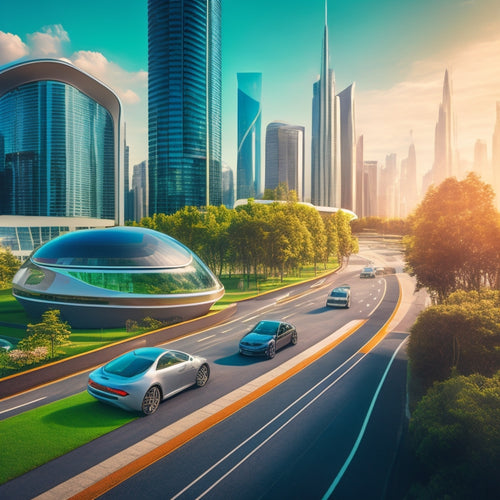
Optimize Retail Energy With These 3 Essential Tools
Share
To optimize your retail energy consumption, you'll need three essential tools. First, analyze your energy usage patterns to identify opportunities to streamline consumption and reduce waste. Next, implement a real-time energy monitoring system to track consumption and pinpoint areas of inefficiency. Finally, use data-driven strategies to develop targeted energy-saving initiatives that drive the greatest impact. By leveraging these tools, you'll tap into significant cost savings and minimize your environmental footprint. As you explore these essential tools, you'll uncover even more ways to refine your energy efficiency strategy and propel your retail business forward.
Key Takeaways
• Conducting regular energy audits helps identify areas of inefficiency and enables data-driven decisions to optimize energy use in retail spaces.
• Real-time energy monitoring systems track energy consumption, pinpointing anomalies and areas of inefficiency to reduce waste and save costs.
• Analyzing energy monitoring data develops targeted energy efficiency strategies, prioritizing initiatives that drive the greatest impact on energy savings.
• Integrating real-time monitoring with sensor calibration provides a precise understanding of energy usage patterns, enabling control over energy budgeting.
• Data-driven decisions optimize energy consumption, reducing waste and saving costs, while educating employees on energy efficiency promotes behavioral shifts that support energy streamlining.
Streamlining Energy Consumption Patterns
By analyzing your store's energy usage patterns, you can identify opportunities to streamline energy consumption and reduce waste.
Conducting regular energy audits helps you pinpoint areas of inefficiency, allowing you to make data-driven decisions to optimize energy use. This process involves examining various aspects of your store's energy consumption, including lighting, HVAC systems, and plug loads.
By identifying patterns and anomalies, you can develop targeted strategies to reduce energy waste and minimize your environmental footprint.
Implementing behavioral shifts is a vital step in streamlining energy consumption.
This involves educating employees on the importance of energy efficiency and encouraging them to adopt energy-conscious habits. Simple changes, such as turning off lights and equipment when not in use, can make a significant impact when combined with more substantial modifications, like upgrading to energy-efficient lighting and appliances.
Real-Time Energy Monitoring Systems
With real-time energy monitoring systems, you can track your store's energy consumption in real-time, allowing you to pinpoint anomalies, identify areas of inefficiency, and make swift adjustments to optimize energy use.
This level of transparency enables you to take control of your energy budgeting, ensuring that you're staying within your means and avoiding unnecessary expenses.
By integrating real-time monitoring with sensor calibration, you'll gain a precise understanding of your energy usage patterns, allowing you to identify opportunities for improvement.
For instance, you might discover that a specific lighting system is consuming more energy than expected, or that a particular department is using more energy than necessary.
With this information, you can make data-driven decisions to optimize your energy consumption, reducing waste and saving costs.
Data-Driven Energy Efficiency Strategies
You can develop targeted energy efficiency strategies by analyzing your real-time energy monitoring data, identifying trends, and pinpointing opportunities to optimize energy usage in your retail operations.
This data-driven approach helps you make informed decisions and prioritize energy-saving initiatives that drive the greatest impact.
By leveraging your energy monitoring data, you can:
Conduct energy audits to identify areas of inefficiency and opportunities for improvement
Establish performance metrics to measure and track energy efficiency progress
Identify opportunities to optimize HVAC, lighting, and other systems
Develop targeted energy efficiency strategies that align with your retail operations' unique needs and goals
Frequently Asked Questions
How Do Energy-Efficient Strategies Impact Employee Productivity?
As you implement energy-efficient strategies, you'll notice a boost in workplace wellness, directly impacting employee morale. By creating a comfortable environment, you're fostering a space where employees thrive, leading to increased productivity and job satisfaction.
Can Energy Management Systems Integrate With Existing Infrastructure?
You'll be relieved to know that modern energy management systems seamlessly integrate with your existing infrastructure, ensuring system compatibility and infrastructure readiness, allowing you to optimize energy usage without disrupting daily operations.
What Is the Average ROI for Energy-Efficient Retail Upgrades?
You'll typically see an average ROI of 15-25% from energy-efficient retail upgrades, resulting in substantial cost savings and financial benefits that directly impact your bottom line, making the investment well worth it.
How Do Energy-Efficient Practices Affect Customer Experience?
You'll find that energy-efficient practices substantially impact customer experience, as ambient lighting and in-store comfort directly influence shopper satisfaction, with well-designed spaces fostering longer visits and increased sales, ultimately driving your retail strategy forward.
Are Energy-Efficient Upgrades Eligible for Government Incentives?
You'll be glad to know that many energy-efficient upgrades qualify for government incentives, including tax credits and rebate programs, which can substantially offset the upfront costs of your eco-friendly investments.
Related Posts
-

Why Certification Matters for Residential Panels
You're looking to understand why certification matters for residential panels. Basically, third-party certification g...
-

Top Portable Solar Panels for Cars to Buy Online
When shopping for portable solar panels for your car, you'll want to take into account reputable brands like Renogy, ...
-

Planning for an Electric Vehicle-Friendly Urban Future
As you plan for an electric vehicle-friendly urban future, you'll need to integrate high-power charging stations, sma...


